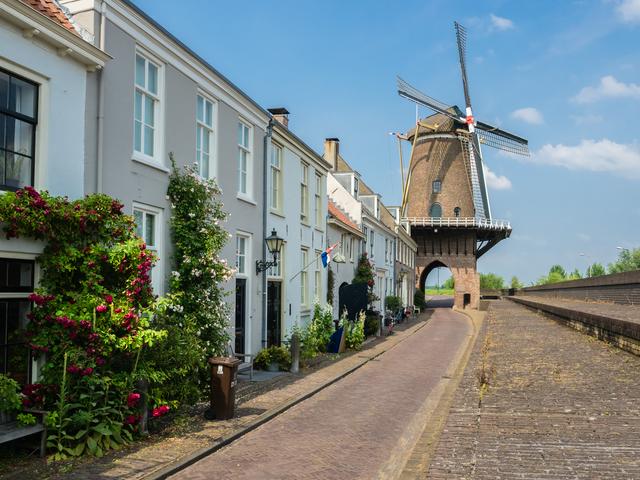Wijk bij Duurstede is a town in Utrecht. It is a typically old Dutch town on the Crooked Rhine River. Dikes galore. Subject of Old Master Jakob Isaackszoon van Ruisdael's 1670 iconic Dutch landscape painting.
 Wijk bij Duurstede, it's name meaning either Settlement near Dorestad or River bend near Dorestad. Dorestad being one of the most important international trade posts before the city's demise caused by Viking raids. Wijk bij Duurstede is located roughly where this city with an estimated ten thousand inhabitants once stood.
Wijk bij Duurstede, it's name meaning either Settlement near Dorestad or River bend near Dorestad. Dorestad being one of the most important international trade posts before the city's demise caused by Viking raids. Wijk bij Duurstede is located roughly where this city with an estimated ten thousand inhabitants once stood.
Dorestad was one of, if not the biggest international trading posts of northwest Europe between the end of the seventh and the middle of the ninth century. The town was founded on the remains of a formerly Roman castellum (castle). The city was inhabited by Frisians, but was located near the border of Frisian and Frankish territories, making the city play a key role in many battles amongst the two tribes. Dorestad finally fel into Frankish hands around 719. The town was transferred to the Danish brothers Rorik and Harald in 840, with the city's demise starting not long after, in the ninth century.
The city's prosperous nature attracted attention from the North, with viking raids, often ending with the town being burned down and parts of its population slaughtered, started in 834, with the last noted time being in 863. The exact cause of Dorestad's demise is not known, but the cause is thought to be either the Viking raids, a sand blockage in the river Rhine, which would have severely limited trade, therefore removing what was so dear to Dorestad; trade. Other theories are the shift of power in the Frankish Empire following Charlemagne's death or the lack of a religious centre (i.e. church) in the city, which left rulers and the elite less interested in Dorestad. Dorestad's fall, however, meant the rise of Tiel, Deventer and later Utrecht.
Wijk bij Duurstede, which can be commonly referred to as Wijk, obtained its city rights in 1300. The town was built on the side of a tower, which would later grow out to become the Duurstede Castle (Kasteel Duurstede). Not late after the city was reinforced with ramparts and a moat. Halfway the fourteenth century the city grew in eastern direction, which also prompted the construction of city walls and the thereto beloning city gates.
- VVV Wijk bij Duurstede/Kromme Rijnstreek, Markt 24, +31 343 575 995.
VVV Wijk bij Duurstede/Kromme Rijnstreek, Markt 24, +31 343 575 995.
- Kasteel Duurstede, Langs de Wal 6, +31 880 001 510.
- Museum Dorestad, Muntstraat 42, +31 343 571 448. 1:30-5 PM. The Dorestad museum features many relics from the ninth century in relation to the many viking raids on Dorestad.
- Runmolenpoort, Dijkstraat 29. The Runmolenpoort and the windmill it has been named after, is a windmill located on top of one of the city gates, making it the only drive-through windmill of the world.
- Sea Shanty and Old Steam boat festival. Last Saturday of September.
Kasteel Duurstede, Langs de Wal 6, +31 880 001 510.
Museum Dorestad, Muntstraat 42, +31 343 571 448. 1:30-5 PM. The Dorestad museum features many relics from the ninth century in relation to the many viking raids on Dorestad.
Runmolenpoort, Dijkstraat 29. The Runmolenpoort and the windmill it has been named after, is a windmill located on top of one of the city gates, making it the only drive-through windmill of the world.
- 't Klooster, Markt 15, +31 343 593 366.
- Stefano's, Volderstraat 8, +31 343 593 188.
- De Kleine, Maleborduurstraat 3, +31 343 225 913.
- De Veldpoort, Veldpoortstraat 21, +31 343 574 350.
- De Engel, Markt 26, +31 343 571 313.
't Klooster, Markt 15, +31 343 593 366.
Stefano's, Volderstraat 8, +31 343 593 188.
De Kleine, Maleborduurstraat 3, +31 343 225 913.
De Veldpoort, Veldpoortstraat 21, +31 343 574 350.
De Engel, Markt 26, +31 343 571 313.
